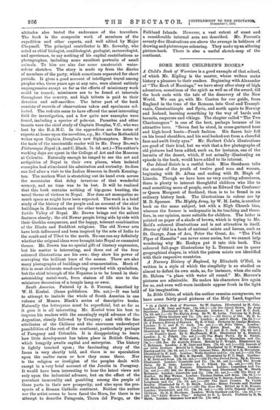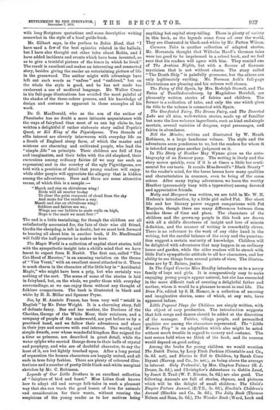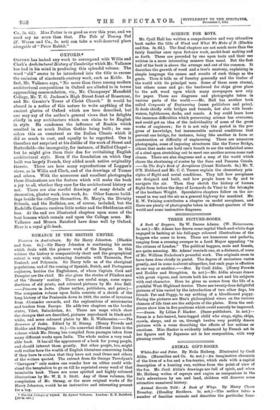SOME MORE CHILDREN'S BOOKS.* A Child's Book of Warriors is
a good example of that school, of which Mr. Kipling is the master, whose writers make history a pleasure to their readers. Beginning with Alexander at "The Rock of Narsinga," we have story after story of high adventure, sometimes of the spirit as well as of the sword, till the book ends with the tale of the discovery of the New World. We can go, with Mr. Canton for our guide, from England in the time of the Romans, into Gaul and Transyl- vania, Constantinople and Syria, and north again to Norway and Iceland, learning something by the way of bards and hermits, emperors and vikings. The chapter called "The Two Charlemagnes " is one of the best, perhaps because of its attractive hero. "Seven feet he stood, in cross-gartered hose and high-laced boots-Frank fashion. His flaxen hair fell on his broad shoulders, and his soul looked out from a cheerful face and swift lively eyes." Mr. Herbert Cole's illustrations are good of their kind, but we wish that a few photographs of old pictures had been added, such as, for instance, one of the hermits of the desert, which, if not actualy- illustrating an episode in the book, would have added to its interest.
Our Island Saints is a restful book. Miss Steedman tells the stories of the youth of twelve good men and women, beginning with St. Alban and ending with St. Hugh of Lincoln. Though we have here no very exciting adventures, there is plenty to interest thoughtful children who like to read something more of people, such as Edward the Confessor or Queen Margaret of Scotland, than is to be found in an ordinary history book. The illustrations in colour are by M. D. Spooner. The Mighty Array, by W. M. Letts, is another book on the same subject, but with a High Church bias, whereas the former is undogmatic in its teaching and there- fore, in our opinion, more suitable for children. The latter is printed on paper of a shade of brown, which is trying to Mr. Reid's coloured illustrations and is not attractive in itself. Stories of Old is a book of national saints and heroes, such as St. George, Joan of Arc, Peter the Great, &c. "The Pied Piper of Hamelin" can never come amiss, but we cannot help wondering why Mr. Hoskyn put it into this book. The coloured full-page illustrations by L. Tennant are in queer geographical shapes, in which the patron saints are identified with their respective countries.
A Nursery History of England, by Elizabeth O'Neil, is written in a style of which the simplicity is so studied as almost to defeat its own ends, as, for instance, when she calls St. Helena "a place with water all round." Mr. Morrow's pictures are admirable. He makes his characters live again for us, and even well-worn incidents appear fresh in the light of his imagination.
In Bible Cities, of which the author remains anonymous, we have some fairly good pictures of the Holy Land, together
• (1) A Child's Book of Warriors. By W. Canton. Illustrated by H. Cole. London J. M. Dent and Sons. [5s. net.]-(2) Our Island Saints. By Amy Stcedman. Illustrated by M. D. Spooner. London T. C. and E. C. Jack. [78. 6d. net.1-(3) The Mighty Army. By W. M. Letts. Pictures by S. Reid. London : Wells Gardner and Co. [5s. net.]-(4) Stories of Old. By E. L. Hoskyn. Illustrated by L. Tennant. London A. and C. Black. [2s. 6d.1- (5) A Nursery History of England. By E. O'Neil. Pictures by George Morrow. London : T. C. and E. C. Jack. [5s. net.]-(6) Bible Cities. London : Thomas Nelson and Sons. [1s.]-(7) Robin Hood. By H. Gilbert. Illustrated by Walter Crane. London : T. C. and E. C. Jack. [7s. 6d. net.] -(8) Trystie's Quest. By G. MacDonald, M.D. Illustrated by A. Hughes. London : A. C. Filleld. 5s. net.]-(9) The Magic World. By E. Nesbit: Illustrated by H. R. dlar and S. Pryse. London : Macmillan and Co. [6s.]-(10) Bee. By Anatole France. Retold by P. Wright. Illustrated by C. Robinson. London : J. M. Dent and Sons. [7s. 6d. net.]-(11) Legends of our little Brothers. Retold by L. Gask. Illustrated by P. Wilson. London : Harrup and Co. [3s. 6d. net.] -(12) Caracan Tales. Retold by J. G. Hornstein. Illustrated by N. Ault. London : Wells Gardner and Co. [5s. net.]-(13) The Fairy of Old Spain. By Mrs. R. Stowell. Illustrated by F. C. Pape. London: J. H. Dent and Sons. [3s. 6d. net.]-(14) The One-Footed Fairy. B7 A. Brown. Illustrated. London : Constable and Co. [3s. 6d. net.]-(151 The Broom Fairy. By E. Gate. London : A. C. Fitield. [Is. ficl. net.]-(16) The Deserted Lake. By E. Burgess. Illustrated. London Longmans and Co. [2s. net.]-(17) Bitt the Minder. Written and Illustrated by W. Heath Robinson. London: Constable and Co. [10s. 6d. net.]-(18) The Story of Heather. By May Wynne. London : Thomas Nelson and Sons. [2s. 6d.]- (19) Molly and Margaret. By Pat. Illustrated by T. Baines, Junior. London : Longinans and Co. [3s. Cd. net.]-(20) The Capri Cousins. By Violet Bradby. Illustrated by C. E. Brock. London : Henry Frowde and Hodder and Stoughton. [2.5. 6d. net.]-(21) The Bran Pte. Edited by S. H. Hamer. London : Duckworth and Co. [3s. 6d. net.]-(22) Little Pageant Plays for Children. By E. E. Blosham. London : Wells Gardner and Co. [is. 01- (23) The "little Women Play." Adapted by E. L. Gould. Pictures by H. Be Birch. London : Sampson Low and Co. [la. net.]
with long Scripture quotations and some descriptive writing somewhat in the style of a local guide-book.
Mr. Gilbert says, in the preface to Robin Hood, that "I have used a few of the best episodes related in the ballads, but I have also thought out other tales about Robin, and I have added incidents and events which have been invented, so as to give a truthful picture of the times in which he lived."
The result is excellent and makes an interesting and connected story, besides giving the reader an entertaining picture of life
in the greenwood. The author might with advantage have
left out such words as " unfree " and " unfriend," but on the whole the style is good, and he has not made too exuberant a use of medieval language. Mr. Walter Crane in his full-page illustrations has avoided the most painful of the shades of the three-colour process, and his knowledge of design and costume is apparent in these examples of his work.
Dr. G. MacDonald, who as the son of the author of
Phantastes has no doubt a more intimate acquaintance with the ways of fairyland than most of us can lay claim to, has written a delightful if rather elaborate story called Trystie's Quest, or Kit King of the Pigwidgeons. Two threads of elfin interest are cleverly interwoven with everyday life on
a South of England sheep farm, of which the master and mistress are charming and cultivated people, who lead the " simple life" on principle. Their children are full of fun and imagina.tidn, and their talks with the old shepherd, their excursions among ordinary fairies (if we may use such an expression) and in the country of the ugly Pigwidgeons, are told with a precision of detail that young readers will enjoy.
while older people will appreciate the allegory that is hidden among the adventures. Here and there are some attractive verses, of which this is a sample :—
"March and rise on chivalrous wing !
Birds will all muster to-day To clear the grim ramparts of cloud from the sky And make for the rainbow a way. March and rise on chivalrous wing! Soldiers and fairies are we ; Wings are our ladders to scale walls on high, Hope is the maid we must free !"
The end is a little tantalizing, for though the children are all satisfactorily accounted for, the fate of their wise old friend, Curdie the sheepdog, is left in doubt; but we must look forward to hearing all about him in another book, if Dr. MacDonald will fulfil the half-promise he makes us here.
The Magic World is a collection of capital short stories, told with the sympathetic insight into a child's mind that we have
learnt to expect from E. Nesbit. The first one, called "The Cat-Hood of Maurice," is an amusing variation on the theme of "Vice Versa," with an excellent moral attached to it. There is much charm in the character of the little boy in "Accidental Magic," who might have been a prig, but who certainly was nothing of the sort. The scene of some of the stories is laid in fairyland, but, on the whole, we prefer those with everyday surroundings, as we can enjoy them without any thought of folklore comparisons. The book is illustrated in black and white by H. R. Millar and Spencer Pryse.
Bee, by M. Anatole France, has been very well "retold in English" by Mr. Peter Wright. It is a charming story, full of delicate fancy. Bee and her mother, the Duchess of the
Clarides, George of the White Moor, their retainers, and a company of people of the underworld, are put before us by a practised hand, and we follow their adventures and share in their joys and sorrows with real interest. The worthy and
simple dwarfs, over whose wonderful kingdom Bee reigned for a time as princess, are described in great detail, while the water sylphs who carried George down to their halls of crystal
and porphyry, and who are of doubtful character, to say the least of it, are but lightly touched upon. After a long period of separation the human characters are happily united, and all ends in true fairy fashion. There are plenty of coloured illus- trations and a number of pretty little black-and-white marginal sketches by Er. C. Robinson.
Legends of Oar Little Brothers is an excellent collection of " fairylore of bird and beast." Miss Lilian Gask knows
bow to adapt old and savage folk-tales in such a pleasant way that she can teach the good lesson of love for animals and consideration for their wants, without rousing the suspicions of the young reader as to her motives being anything but capital story-telling. There is plenty of variety in this book, as the legends come from all over the world.
They are illustrated in black-and-white by Mr. Patten Wilson.
Caravan Tales is another collection of adapted stories. Mr. Hornstein thought that Wilhelm Hauff's German tales
were too good to be imprisoned in a school book, and we feel
sure that his readers will agree with him. They remind one of The Arabian Nights, but with a flavour of German
mysticism that is not without charm. The story called "The Death Ship" is painfully gruesome, but the others are only legitimately exciting. Mr. Norman Ault's full-page illustrations are pleasing and his colours well chosen.
The Fairy of Old Spain, by Mrs. Rodolph Stawell, and The Twins of Tumbledownclreary, by Magdalene Horsfall, are
pleasantly written stories of fairies and children. The former is a collection of tales, and only the one which gives its title to the volume is connected with Spain.
The One-footed Fairy, The Broom Fairy, and The Deserted Lake are all nice, well-written stories, made up of familiar
but none the less welcome ingredients, such as kind and simple mortals, several varieties of dragons, royal personages, and fairies in abundance.
Bill the Minder, written and illustrated by W. Heath Robinson, is a large handsome volume. The style and the adventures seem ponderous to us, but the readers for whom it is intended may pass another judgment on it.
In The Story of Heather May Wynne gives us the auto- biography of an Exmoor pony. The writing is lively and the
story moves quickly, even if it is at times a little too senti- mental for our taste. It recalls Miss Sewell's "Black Beauty" to the reader's mind, for the horse heroes have many qualities and characteristics in common, even to being of the same colour. After many trying adventures, we leave the worthy Heather (presumably busy with a typewriter) among devoted and appreciative friends.
Molly and Margaret was written, we are told in Mr. W. H. Hudson's introduction, by a little girl called Pat. Her short
life and her literary power suggest comparisons with Pet Marjorie, though there are many differences between them besides those of time and place. The characters of the children and the grown-up people in this book are drawn
with all a child's directness of insight and love of minute definition, and the manner of writing is remarkably clever.
There is no reference to the work of any older band in the writing, but the careful balance of the story and the punctua- tion suggest a certain maturity of knowledge. Children will be delighted with adventures that may happen in an ordinary house and garden, while the older readers will be struck with little Pat's sympathetic attitude to all her characters, and her ability to see things from several points of view. The illustra. tions are by T. Baines, junior.
In The Capel Cousins Miss Bradby introduces us to a merry family of boys and girls. It is comparatively easy to make
engaging young people appear natural, but she has succeeded
in the more difficult task of creating a delightful father and mother, whom it would be a pleasure to meet in real life. The Bran Pie, edited by S. H. Hamer, is a collection of amusing and imaginative stories, some of which, at any rate, have appeared before.
Little Pageant Plays for Children are simply written, with the object of easy production. The introduction suggests that folk songs and dances should be added at the discretion of the manager. Fairies, village people, and personified qualities are among the characters represented. The "Little Women Play" is an adaptation which also might be acted without much trouble in regard to scenery and costume. The text seems bald when we think of the book, and its success would depend on good acting.
Among the books for young children we would mention The Dutch Twins, by Lucy Fitch Perkins (Constable and Co., 3s. 6d. net), and Stories to Tell to Children, by Sarah Cone Bryant (Harrap and Co., 5s. net.), as being above the average in interest. Only Pretendin', by Mrs. Clayton Palmer (H. J. Drane, 3s. 6d.), and Christopher's Adventures in Goblin Land, by Janet S. Trail (W. P. Nimmo, Is. 6d.) are also good. The following Annuals are full of stories, rhymes, and pictures which will be the delight of small children: The Child's Empire Picture Annual, (R.T.S., 3s. 6d.), Blackie's Children's Annual (Blackie and Co., 38. 6d.), The Jolly Book (Thomas Nelson and Sons, 2e. 6d.), The Wonder Book (Ward, Lock and Co., 3s. 6d.). Miss Potter is as good as ever this year, and we need say no more than that. The Tale of Tommy Tod (F. Warne and Co., Is. net) can take a well-deserved place alongside of "Peter Rabbit."








































































 Previous page
Previous page